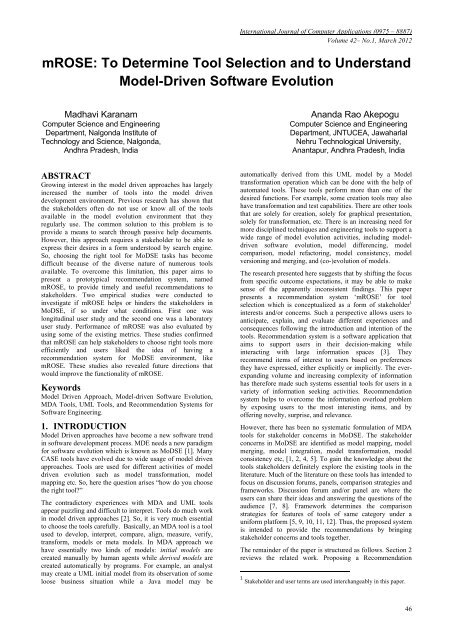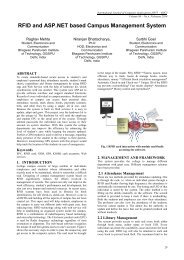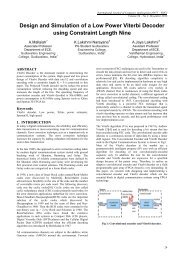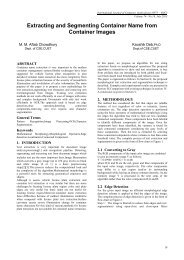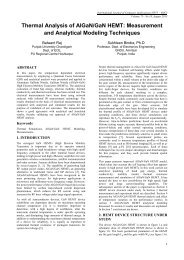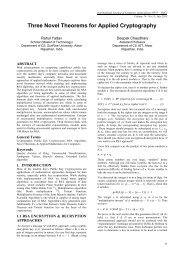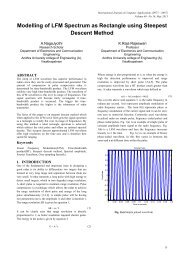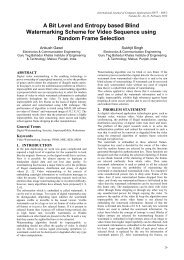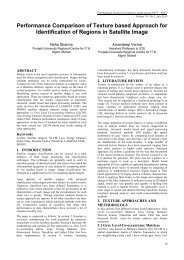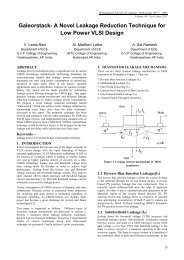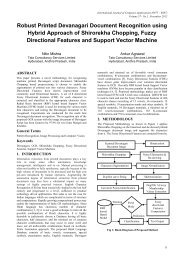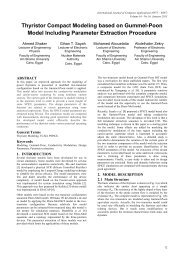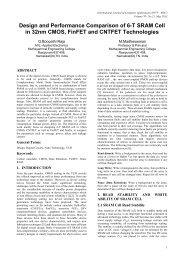mROSE - International Journal of Computer Applications - IJCA
mROSE - International Journal of Computer Applications - IJCA
mROSE - International Journal of Computer Applications - IJCA
Create successful ePaper yourself
Turn your PDF publications into a flip-book with our unique Google optimized e-Paper software.
<strong>International</strong> <strong>Journal</strong> <strong>of</strong> <strong>Computer</strong> <strong>Applications</strong> (0975 – 8887)<br />
Volume 42– No.1, March 2012<br />
<strong>mROSE</strong>: To Determine Tool Selection and to Understand<br />
Model-Driven S<strong>of</strong>tware Evolution<br />
Madhavi Karanam<br />
<strong>Computer</strong> Science and Engineering<br />
Department, Nalgonda Institute <strong>of</strong><br />
Technology and Science, Nalgonda,<br />
Andhra Pradesh, India<br />
ABSTRACT<br />
Growing interest in the model driven approaches has largely<br />
increased the number <strong>of</strong> tools into the model driven<br />
development environment. Previous research has shown that<br />
the stakeholders <strong>of</strong>ten do not use or know all <strong>of</strong> the tools<br />
available in the model evolution environment that they<br />
regularly use. The common solution to this problem is to<br />
provide a means to search through passive help documents.<br />
However, this approach requires a stakeholder to be able to<br />
express their desires in a form understood by search engine.<br />
So, choosing the right tool for MoDSE tasks has become<br />
difficult because <strong>of</strong> the diverse nature <strong>of</strong> numerous tools<br />
available. To overcome this limitation, this paper aims to<br />
present a prototypical recommendation system, named<br />
<strong>mROSE</strong>, to provide timely and useful recommendations to<br />
stakeholders. Two empirical studies were conducted to<br />
investigate if <strong>mROSE</strong> helps or hinders the stakeholders in<br />
MoDSE, if so under what conditions. First one was<br />
longitudinal user study and the second one was a laboratory<br />
user study. Performance <strong>of</strong> <strong>mROSE</strong> was also evaluated by<br />
using some <strong>of</strong> the existing metrics. These studies confirmed<br />
that <strong>mROSE</strong> can help stakeholders to choose right tools more<br />
efficiently and users liked the idea <strong>of</strong> having a<br />
recommendation system for MoDSE environment, like<br />
<strong>mROSE</strong>. These studies also revealed future directions that<br />
would improve the functionality <strong>of</strong> <strong>mROSE</strong>.<br />
Keywords<br />
Model Driven Approach, Model-driven S<strong>of</strong>tware Evolution,<br />
MDA Tools, UML Tools, and Recommendation Systems for<br />
S<strong>of</strong>tware Engineering.<br />
1. INTRODUCTION<br />
Model Driven approaches have become a new s<strong>of</strong>tware trend<br />
in s<strong>of</strong>tware development process. MDE needs a new paradigm<br />
for s<strong>of</strong>tware evolution which is known as MoDSE [1]. Many<br />
CASE tools have evolved due to wide usage <strong>of</strong> model driven<br />
approaches. Tools are used for different activities <strong>of</strong> model<br />
driven evolution such as model transformation, model<br />
mapping etc. So, here the question arises ―how do you choose<br />
the right tool?‖<br />
The contradictory experiences with MDA and UML tools<br />
appear puzzling and difficult to interpret. Tools do much work<br />
in model driven approaches [2]. So, it is very much essential<br />
to choose the tools carefully. Basically, an MDA tool is a tool<br />
used to develop, interpret, compare, align, measure, verify,<br />
transform, models or meta models. In MDA approach we<br />
have essentially two kinds <strong>of</strong> models: initial models are<br />
created manually by human agents while derived models are<br />
created automatically by programs. For example, an analyst<br />
may create a UML initial model from its observation <strong>of</strong> some<br />
loose business situation while a Java model may be<br />
Ananda Rao Akepogu<br />
<strong>Computer</strong> Science and Engineering<br />
Department, JNTUCEA, Jawaharlal<br />
Nehru Technological University,<br />
Anantapur, Andhra Pradesh, India<br />
automatically derived from this UML model by a Model<br />
transformation operation which can be done with the help <strong>of</strong><br />
automated tools. These tools perform more than one <strong>of</strong> the<br />
desired functions. For example, some creation tools may also<br />
have transformation and test capabilities. There are other tools<br />
that are solely for creation, solely for graphical presentation,<br />
solely for transformation, etc. There is an increasing need for<br />
more disciplined techniques and engineering tools to support a<br />
wide range <strong>of</strong> model evolution activities, including modeldriven<br />
s<strong>of</strong>tware evolution, model differencing, model<br />
comparison, model refactoring, model consistency, model<br />
versioning and merging, and (co-)evolution <strong>of</strong> models.<br />
The research presented here suggests that by shifting the focus<br />
from specific outcome expectations, it may be able to make<br />
sense <strong>of</strong> the apparently inconsistent findings. This paper<br />
presents a recommendation system ‗<strong>mROSE</strong>‘ for tool<br />
selection which is conceptualized as a form <strong>of</strong> stakeholder 1<br />
interests and/or concerns. Such a perspective allows users to<br />
anticipate, explain, and evaluate different experiences and<br />
consequences following the introduction and intention <strong>of</strong> the<br />
tools. Recommendation system is a s<strong>of</strong>tware application that<br />
aims to support users in their decision-making while<br />
interacting with large information spaces [3]. They<br />
recommend items <strong>of</strong> interest to users based on preferences<br />
they have expressed, either explicitly or implicitly. The everexpanding<br />
volume and increasing complexity <strong>of</strong> information<br />
has therefore made such systems essential tools for users in a<br />
variety <strong>of</strong> information seeking activities. Recommendation<br />
system helps to overcome the information overload problem<br />
by exposing users to the most interesting items, and by<br />
<strong>of</strong>fering novelty, surprise, and relevance.<br />
However, there has been no systematic formulation <strong>of</strong> MDA<br />
tools for stakeholder concerns in MoDSE. The stakeholder<br />
concerns in MoDSE are identified as model mapping, model<br />
merging, model integration, model transformation, model<br />
consistency etc, [1, 2, 4, 5]. To gain the knowledge about the<br />
tools stakeholders definitely explore the existing tools in the<br />
literature. Much <strong>of</strong> the literature on these tools has intended to<br />
focus on discussion forums, panels, comparison strategies and<br />
frameworks. Discussion forum and/or panel are where the<br />
users can share their ideas and answering the questions <strong>of</strong> the<br />
audience [7, 8]. Framework determines the comparison<br />
strategies for features <strong>of</strong> tools <strong>of</strong> same category under a<br />
uniform platform [5, 9, 10, 11, 12]. Thus, the proposed system<br />
is intended to provide the recommendations by bringing<br />
stakeholder concerns and tools together.<br />
The remainder <strong>of</strong> the paper is structured as follows. Section 2<br />
reviews the related work. Proposing a Recommendation<br />
1 Stakeholder and user terms are used interchangeably in this paper.<br />
46
System in Model-Driven S<strong>of</strong>tware Evolution Context is the<br />
primary contribution <strong>of</strong> this paper which is discussed in the<br />
section 3. Evaluation <strong>of</strong> <strong>mROSE</strong> is presented in the section 4.<br />
Section 5 closes with conclusions and future work.<br />
2. RELATED WORK<br />
This section outlines the comparison strategies, forums,<br />
panels for MDA and UML tools and also about the<br />
recommendation systems for s<strong>of</strong>tware engineering. Many<br />
more recommendation systems are available for s<strong>of</strong>tware<br />
engineering. But few recommendation systems are discussed<br />
here.<br />
2.1 Tools<br />
Integrated constrain support in MDA tools evaluated in [13].<br />
The different tools were classified in Categories like CASE<br />
tools, MDA specific tools, MDD methods and OCL tools.<br />
MDA-tools considered in the classification are closest to the<br />
MDA standard. Only few tools such as Poseidon, Rational<br />
Rose, Magic Draw, Objecteering/UML , Together ,ArcStyler,<br />
OptimalJ and AndroMDA etc, have selected for the<br />
comparison and evaluation purpose. The support <strong>of</strong> current<br />
tools regarding the automatic generation <strong>of</strong> the code required<br />
to enforce the Integrated Constraints specified in a PIM also<br />
surveyed. The main shortcomings encountered are the lack <strong>of</strong><br />
expressivity and efficiency in integrated constraints.<br />
A short comparison <strong>of</strong> the three MDA tools was presented in<br />
[11]. It was focused on the concepts behind the tools as well<br />
as how to use them. The tools considered for comparison are<br />
ArchitectureWare, AndroMDA, and openMDX. The<br />
comparison strategy presented might be useful for evaluation<br />
purposes to find out about the differences in approach,<br />
features and concepts which are to be considered as the<br />
implementation <strong>of</strong> OMG‘s MDA specification.<br />
<strong>Computer</strong> Aided S<strong>of</strong>tware Engineering tool Community is an<br />
open access web application. In which the different categories<br />
<strong>of</strong> the CASE tools like MDA, UML, reverse engineering,<br />
agile modeling etc. are listed. The key functions, external<br />
links, and rating <strong>of</strong> the tools are provided. modelbased.net<br />
forum [7] is dedicated to tools and information related to<br />
model-driven system development, aiming at supporting<br />
OMG‘s vision MDA are provided. This website provides the<br />
over view and the resource links <strong>of</strong> MDA oriented tools,<br />
UML, MOF, and Model transformation tools.<br />
MDA tools are categorized in three ways in [12]. The first,<br />
whether the tool is open source or commercial, will help to<br />
choose a tool that is right for the culture <strong>of</strong> an organization,<br />
among other things. The second, whether the tool <strong>of</strong>fers a<br />
partial or complete MDA solution, will helps in such<br />
considerations as cost, quality, and flexibility. The final<br />
category, whether the tool generates code from the model or<br />
executes the model. It is not mentioned what are the tools that<br />
fits in to the specified categories. IBM Rational s<strong>of</strong>tware has<br />
several products that support MDA and Model Driven<br />
Development (MDD) in varying capacities [11]. These tools<br />
fall into three basic categories such as general-purpose,<br />
domain-specific, and supporting. For example Rational<br />
S<strong>of</strong>tware Architect is in general-purpose category, IBM<br />
Rational Systems Developer in domain-specific category, and<br />
IBM WebSphere Business Modeler in the supporting<br />
category. The usage <strong>of</strong> these tools in MDA was described.<br />
Here only IBM products are considered for categorization.<br />
Above mentioned forum, panel and community are only the<br />
information content <strong>of</strong> the tools which do not provide the auto<br />
suggestions about the tools for different activities <strong>of</strong> MoDSE.<br />
<strong>International</strong> <strong>Journal</strong> <strong>of</strong> <strong>Computer</strong> <strong>Applications</strong> (0975 – 8887)<br />
Volume 42– No.1, March 2012<br />
2.2 Recommendation Systems for S<strong>of</strong>tware<br />
Engineering<br />
The Strathcona system [14] retrieves relevant source code<br />
examples to help developers use frameworks effectively. For<br />
example, a developer who‘s trying to figure out how to<br />
change the status bar in the Eclipse IDE can highlight the partially<br />
complete code (the context) and ask Strathcona for<br />
similar examples. Strathcona extracts a set <strong>of</strong> structural facts<br />
from the code fragment. Strathcona uses PostgreSQL queries<br />
to search for occurrences <strong>of</strong> each fact in a code repository.<br />
Next, it uses a set <strong>of</strong> heuristics to decide on the best examples,<br />
which it orders according to how many heuristics select them.<br />
It returns the top 10 examples, displaying them in two formats<br />
- a structural overview diagram and highlighted source code.<br />
Developers can also view a rationale for a proposed example.<br />
A prototype is also available in.<br />
Dhruv is a Recommendation System [15] which recommends<br />
people and artifacts relevant to a bug report. It operates<br />
chiefly in the open source community, which interacts heavily<br />
via the Web. Using a three-layer model <strong>of</strong> community<br />
(developers, users, and contributors), content (code, bug<br />
reports, and forum messages), and interactions between these,<br />
Dhruv constructs a according to the similarity between a bug<br />
report and the terms contained in the object and its metadata.<br />
Finding the right s<strong>of</strong>tware experts to consult can be difficult,<br />
especially when they‘re geographically distributed. Expertise<br />
Browser [16] is a tool that recommends people by detecting<br />
past changes to a given code location or document. It assumes<br />
that developers who changed a method have expertise in it.<br />
ParseWeb [17] recommends sequences <strong>of</strong> method calls<br />
starting from an available object type and producing a desired<br />
object type. ParseWeb analyzes example code found on the<br />
Web to identify frequently occurring call patterns that link<br />
available object types with desired object types. Developers<br />
use the tool by specifying available and desired object types<br />
and requesting recommendations.<br />
To date, most Recommendation Systems for s<strong>of</strong>tware<br />
engineering (RSSE) have focused on recommendations<br />
related to s<strong>of</strong>tware development artifacts, particularly source<br />
code. RSSEs typically recommend code—to look at, change,<br />
or reuse. However, recommendations could address many<br />
other aspects <strong>of</strong> s<strong>of</strong>tware development such as quality<br />
measures, tools, project management, and people could<br />
support an ever-widening array <strong>of</strong> s<strong>of</strong>tware engineering tasks.<br />
Recommendation system might use activity logs to deduce<br />
questions developers ask, and then coach them automatically<br />
on appropriate, possibly unfamiliar tools or features to answer<br />
those questions more efficiently [18].<br />
Thus, the proposed system provides the recommendations for<br />
tool selection in the context <strong>of</strong> Model-Driven S<strong>of</strong>tware<br />
Evolution. It is different from the above mentioned forums<br />
and communities. The proposed system brings tools, MoDSE<br />
concerns, and stakeholders together and it is described in the<br />
next section.<br />
3. PROPOSED SYSTEM<br />
Many stakeholders spend substantial effort in finding out<br />
appropriate tool among the huge number, to perform activities<br />
in MoDSE. The major goal <strong>of</strong> this paper is to bring<br />
stakeholder, tools and concerns together and assist in selecting<br />
appropriate tool suitable to accomplish concerns <strong>of</strong> interest.<br />
The following sections demonstrate the design issues and<br />
different components <strong>of</strong> the proposed System.<br />
47
Recommendation System for S<strong>of</strong>tware Engineering (RSSE) is<br />
defined in as ―a s<strong>of</strong>tware application that provides information<br />
items estimated to be valuable for a s<strong>of</strong>tware engineering task<br />
in a given context‖. <strong>mROSE</strong>, the proposed recommendation<br />
system, generates useful tool recommendations for users to<br />
understand evolution <strong>of</strong> the models in the Model-Driven<br />
S<strong>of</strong>tware Evolution. The design dimensions, characteristics<br />
and other concepts <strong>of</strong> RSSE are available in [17] and the<br />
design dimensions like nature <strong>of</strong> the context, recommendation<br />
engine, and output modes are considered for the proposed<br />
<strong>mROSE</strong>.<br />
3.1 Components <strong>of</strong> the <strong>mROSE</strong><br />
<strong>mROSE</strong> consists <strong>of</strong> four major components: Basic Mode,<br />
Expert Mode, Tool Comparison and Knowledge Base. Based<br />
on the user pr<strong>of</strong>ile two modes <strong>of</strong> interaction are provided.<br />
Tool Comparison is responsible for generating<br />
recommendations. Knowledge Base is the information space<br />
where user can explore detailed information about concerns<br />
and tools. <strong>mROSE</strong> can also be connected to the web for<br />
further expansion. Details <strong>of</strong> each component are provided in<br />
the rest <strong>of</strong> this section.<br />
3.1.1 Basic Mode<br />
This mode <strong>of</strong> operation is for a beginner who is not well<br />
versed with the terminology associated with MoDSE and<br />
MDA tools. Basic Mode (Fig.1a) lists all the possible<br />
concerns <strong>of</strong> MoDSE and allows the user to select the<br />
interested concerns while providing an option to learn more<br />
about these concerns. After selecting interested concerns, user<br />
can click the button titled ‗Get tools for Selected Concerns’ to<br />
list all tools that support user‘s selection. Further user can<br />
select few suggested tools and use the button titled ‗Compare<br />
Selected Tools’ to enable Tool Comparison component that<br />
generates comparison summary and recommendations based<br />
on the number <strong>of</strong> concerns selected by the user and number <strong>of</strong><br />
concerns satisfied by the tool.<br />
3.1.2 Expert Mode<br />
Expert Mode allows the user who has the knowledge about<br />
the MoDSE and MDA tools. Interface (Fig.1b) allows the user<br />
to search for interested concerns with search option and auto<br />
suggestions. It populates the list <strong>of</strong> the selected concerns.<br />
Recommendations are generated for the selected concerns.<br />
Comparison summary <strong>of</strong> the selected recommended tools are<br />
presented from which identifying the right tool becomes easy<br />
for a user.<br />
3.1.3 Tool Comparison<br />
This component lists the tools which are useful to understand<br />
the evolution <strong>of</strong> the models in MoDSE. Tools are categorized<br />
as MDA and UML tools, and also as Non-Commercial and<br />
Commercial tools. Tool Comparison generates the<br />
comparison summary <strong>of</strong> similarities and dissimilarities <strong>of</strong> the<br />
selected tools. Tool Comparison component implicitly works<br />
as a recommendation engine which generates the<br />
recommendations for the user interest. Comparison and<br />
Recommendation buttons (Fig 1c and Fig 1d) are used to view<br />
<strong>International</strong> <strong>Journal</strong> <strong>of</strong> <strong>Computer</strong> <strong>Applications</strong> (0975 – 8887)<br />
Volume 42– No.1, March 2012<br />
the comparison summary and the recommendations based on<br />
the user selected concerns, tools and the number <strong>of</strong> concerns<br />
satisfied by the selected tool.<br />
3.1.4 Knowledge Base<br />
Knowledge Base is an information repository where the<br />
complete content <strong>of</strong> the tools, description <strong>of</strong> various concerns<br />
<strong>of</strong> MoDSE and other related information about Models, UML<br />
diagrams etc. are available. User can capture and gain the<br />
knowledge about MoDSE from the search option (Fig. 1e).<br />
<strong>mROSE</strong> can be connected to web thru this component helping<br />
user to explore more information and also to overcome the<br />
limited information space <strong>of</strong> the repository. Users can leave<br />
feedback about <strong>mROSE</strong> using Post Comment option and (Fig.<br />
1f.)<br />
3.1.5 Algorithm<br />
Recommendation engine algorithm is constructed by<br />
determining various tool similarities and algorithm used here<br />
is available in the literature as Item-Based schemas [19]. The<br />
following symbols are used in the algorithm.<br />
N = number <strong>of</strong> recommendations that need to be<br />
generated for a particular user<br />
n = number <strong>of</strong> distinct users<br />
m = number <strong>of</strong> distinct tools in a particular transaction,<br />
user selecting the concerns, selecting the appropriate<br />
tools considered as a transaction.<br />
k = number <strong>of</strong> similar tools<br />
Input to this algorithm is the model M, an m× 1 vector U that<br />
stores items that have been selected by the active user. Active<br />
user‘s information in vector U is encoded by setting Ui = 1 if<br />
the user has selected i th tool and zero otherwise. Output <strong>of</strong><br />
this algorithm is an m×1 vector x whose nonzero entries<br />
correspond to the number <strong>of</strong> items to be recommended (N).<br />
Weight <strong>of</strong> these nonzero entries represents a measure <strong>of</strong> the<br />
recommendation strength and various recommendations can<br />
be ordered in non-increasing recommendation. In most cases x<br />
will have exactly N nonzero entries; however, actual number<br />
<strong>of</strong> recommendations can be less than N as it depends on the<br />
value <strong>of</strong> k used to build M and the number <strong>of</strong> items that have<br />
already been selected by active user.<br />
Algorithm : RecommndGen (M, U, N)<br />
x ←MU (1)<br />
for j ← 1 to m (2)<br />
do<br />
if U i ≠ 0<br />
then x i ← 0<br />
48
Fig 1: <strong>mROSE</strong> User Interface<br />
Fig 1a: Basic Mode with List <strong>of</strong> Selected Concerns and Actions<br />
<strong>International</strong> <strong>Journal</strong> <strong>of</strong> <strong>Computer</strong> <strong>Applications</strong> (0975 – 8887)<br />
Volume 42– No.1, March 2012<br />
Fig 1b: Expert mode with search and auto suggestions options and Actions<br />
Fig 1c: Comparison summary <strong>of</strong> selected tools in Tool Comparison<br />
49
for j ← 1 to m (3)<br />
do<br />
if x i≠ among the N largest values in x<br />
Fig 1d: Recommendations generated in Tool Comparison<br />
Fig 1e: Information capturing from Knowledge Base<br />
Fig 1f: Feedback Form <strong>of</strong> <strong>mROSE</strong> in the Knowledge Base<br />
<strong>International</strong> <strong>Journal</strong> <strong>of</strong> <strong>Computer</strong> <strong>Applications</strong> (0975 – 8887)<br />
Volume 42– No.1, March 2012<br />
then x i ← 0<br />
return (x)<br />
50
Vector x is computed in three steps. First, vector x is<br />
computed by multiplying M with U (line 1). Note that the<br />
nonzero entries <strong>of</strong> x correspond to union <strong>of</strong> k most similar<br />
concerns for each tool that has already been selected by an<br />
active user, and weight <strong>of</strong> these entries is nothing more than<br />
the sum <strong>of</strong> these similarities. Second, the entries <strong>of</strong> x that<br />
correspond to tools that have already been selected by an<br />
active user are set to zero (loop at line 2). Finally, in third<br />
step, the algorithm sets to zero and all entries <strong>of</strong> x that have a<br />
value smaller than the N largest values <strong>of</strong> x (loop at line 3).<br />
Comparison between the tools is computed as an<br />
ItemSimilarity by using MapReduce [20,21] framework<br />
which shields the programmer from distributed processing<br />
issues such as synchronization, data exchange, and load<br />
balancing. Existing MapReduce [21] technique is used in this<br />
research to compute pair wise similarity between the tools.<br />
This technique is selected because <strong>of</strong> its efficiency in<br />
computing pair wise similarity for large collections. In this<br />
paper pair wise tool similarity can be expressed as an inner<br />
product <strong>of</strong> concern weights. A tool t is represented as a vector<br />
W t <strong>of</strong> concern weights w c,t , which indicates the importance <strong>of</strong><br />
each concern c in that tool by considering symmetric<br />
similarity measure, which is defined as follows:<br />
Where similarity between tools ti and tj and V is is<br />
the concern set. In this type <strong>of</strong> similarity measure, a concern<br />
will contribute to the similarity between two tools only if it<br />
has non-zero weights in both. Therefore, can be replaced<br />
with in equation (1). For example, if a concern<br />
appears in tools x,y, and z, it contributes only to the similarity<br />
scores between (x,y),(x,z) and (y,z). The list <strong>of</strong> tools that<br />
contain a particular concern is exactly retrieved. Thus,<br />
processing all retrieves, entire pair wise similarity matrix can<br />
compute by summing concern contributions.<br />
Algorithm : Compute Tool Similarity Matrix<br />
1: i, j : sim[i, j] 0<br />
2: for all do<br />
3: r c retrieves(c)<br />
4: for all r c do<br />
5: sim[i, j] sim[i, j] +<br />
Algorithm formalizes the idea: retrieves(c) denotes list <strong>of</strong><br />
tools that contain concern c. In <strong>mROSE</strong> prototype model,<br />
information space <strong>of</strong> tools and concerns considered is small.<br />
So, this algorithm runs efficiently to compute entire similarity<br />
matrix in memory. For larger collections disk access<br />
optimization is needed, which is provided by the MapReduce<br />
[29, 30] runtime, without requiring explicit coordination. In<br />
<strong>mROSE</strong> comparison report is treated as an n×m matrix, where<br />
n is the total number <strong>of</strong> concerns and m is the concerns<br />
present in selected tools. If the concern is present in a tool,<br />
that is treated as a ‗YES‘ if not ‗NO‘. Increase in number <strong>of</strong> n<br />
and m, increases the number <strong>of</strong> iterations which in turn<br />
increases computation complexity. This can be reduced by<br />
(1)<br />
<strong>International</strong> <strong>Journal</strong> <strong>of</strong> <strong>Computer</strong> <strong>Applications</strong> (0975 – 8887)<br />
Volume 42– No.1, March 2012<br />
reducing the number <strong>of</strong> iterations by assuming that number <strong>of</strong><br />
concerns fixed (n) and number <strong>of</strong> tools may vary (m).<br />
4. <strong>mROSE</strong> EVALUATION<br />
This section describes the validation <strong>of</strong> the proposed <strong>mROSE</strong><br />
prototype model by longitudinal and laboratory user studies.<br />
Standard evaluation techniques that refer directly to the<br />
performance metrics [22] related to time, storage requirements<br />
and computation complexity is used to evaluate the<br />
performance <strong>of</strong> <strong>mROSE</strong>.<br />
4.1 Longitudinal User Study<br />
A formal evaluation <strong>of</strong> <strong>mROSE</strong> system is needed to determine<br />
whether and under what conditions this system help or hinder<br />
the users. These evaluations can also help assess whether<br />
benefits <strong>of</strong> <strong>mROSE</strong> system support the users need or not. To<br />
evaluate the value and acceptance <strong>of</strong> prototype <strong>of</strong> <strong>mROSE</strong>, a<br />
longitudinal user study has conducted with 15 participants<br />
who are academicians and research students from diverse<br />
organizations. Longitudinal User Study aimed to answer nine<br />
different tasks which consist <strong>of</strong> questions about MoDSE<br />
concerns, activities, and tools. Due to the space limitation nine<br />
tasks are not mentioned here. Since <strong>mROSE</strong> prototype model<br />
could only recommend 60 tools at the moment.<br />
To observe the effect, efficiency and usability <strong>of</strong> <strong>mROSE</strong>,<br />
longitudinal study was divided into two phases: In First Phase,<br />
answering the nine tasks without using <strong>mROSE</strong> system;<br />
Second Phase, answering the nine tasks with the help <strong>of</strong><br />
<strong>mROSE</strong>. During the first phase, <strong>mROSE</strong> was disabled to the<br />
participants, meaning that participants could not interact with<br />
<strong>mROSE</strong> or receive any information/knowledge to solve nine<br />
tasks. Participants have recorded the time taken (man hours)<br />
to answer each task as shown in the Table 1 and columns from<br />
P1 to P15 represent the participants and rows Tk1 to Tk9<br />
represent task1 to task9. Values in Table 1 are time taken to<br />
answer the each task by each participant measured in minutes<br />
(man hours). Average time taken to answer each task by 15<br />
users also computed and it is shown in Table 1.<br />
After completion <strong>of</strong> the first phase participants remarked that<br />
answering the tasks required lot <strong>of</strong> information gathering from<br />
distinct sources like communities, forums, social networks,<br />
websites, search engines etc. So, it is not only a time<br />
consuming and tiresome job but also information gathered<br />
may be accurate and may not be. Participants who do not have<br />
an idea about MoDSE claimed that for few questions they<br />
didn‘t get the answers and approaching communities and<br />
forums did not worked out. From the results in the Table 1, it<br />
is clear that answering tasks is time consuming and the<br />
participants who do not have knowledge about MoDSE took<br />
more time compared with the participants who have<br />
knowledge about MoDSE.<br />
After each participant had finished the first phase they were<br />
asked to start second phase. During this phase participants<br />
were answering the same nine tasks with using <strong>mROSE</strong>. Time<br />
taken to complete each task by each participant is recorded<br />
and it is shown in the Table 2. Participants reported that<br />
answering the tasks with help <strong>of</strong> <strong>mROSE</strong> reduced the time for<br />
searching various sources to gather the information further<br />
reducing effort and difficulty in getting right information.<br />
From the comparison results in Table 1 and Table 2, time<br />
taken to complete the tasks has drastically reduced.<br />
51
Table 1. Results During First Phase <strong>of</strong> Longitudinal Study (without using <strong>mROSE</strong>)<br />
Participants<br />
Table 2. Results During Second Phase <strong>of</strong> Longitudinal Study (using <strong>mROSE</strong>)<br />
<strong>International</strong> <strong>Journal</strong> <strong>of</strong> <strong>Computer</strong> <strong>Applications</strong> (0975 – 8887)<br />
Volume 42– No.1, March 2012<br />
P1 P2 P3 P4 P5 P6 P7 P8 P9 P10 P11 P12 P13 P14 P15 Average<br />
Task 1 40 45 35 28 25 38 48 48 35 90 60 90 51 60 60 50.2<br />
Task 2 45 35 90 120 30 100 80 90 90 45 45 35 50 50 90 66.33<br />
Task 3 35 25 30 28 30 100 35 75 25 25 60 90 25 90 90 50.8<br />
Task 4 25 60 69 60 25 25 25 60 35 40 35 45 40 40 35 41.27<br />
Task 5 20 30 38 58 105 35 25 25 25 35 40 50 70 80 90 48.4<br />
Task 6 20 30 30 20 20 25 35 40 35 30 30 35 20 20 20 26.67<br />
Task 7 30 60 60 60 60 60 60 30 30 35 30 30 30 30 30 42.33<br />
time<br />
(minutes)<br />
Task 8 50 90 100 150 100 120 120 130 140 140 135 135 130 135 150 121.67<br />
Task 9 40 45 45 55 65 40 40 45 65 75 45 65 75 90 90 58.67<br />
Participants<br />
P1 P2 P3 P4 P5 P6 P7 P8 P9 P10 P11 P12 P13 P14 P15 Average<br />
Task 1 5 8 9 9 9 5 7 5 7 7.5 9.5 10 10 10 10 8.07<br />
Task 2 7 7 10 10 12 6 7.5 7.5 8 10 12 12 12 15 15 10.07<br />
Task 3 10 10 10 9 15 10 9 8 10 9.5 7.5 9.5 19 15 15 11.1<br />
Task 4 5 5 5 15 10 10 15 9 12 10 10 10 18 19 10 10.87<br />
Task 5 5 5 5 5 10 10 5 8 7 10 10 10 10 10 10 8.0<br />
Task 6 3 3 5 3 5 2 3 5 4 5 5 5 5 5 4 4.13<br />
Task 7 3 3 4 4 4 3 4 5 5 5 5 4 4 4 4 4.35<br />
Task 8 30 30 40 40 35 35 30 45 40 40 35 30 35 30 30 35<br />
time<br />
(minutes)<br />
Task 9 15 15 20 20 25 15 18 20 25 15 15 20 20 20 20 25.53<br />
52
4.2 Laboratory User Study<br />
The experimental study is essential to determine user<br />
perception towards prototype model <strong>of</strong> <strong>mROSE</strong>. Laboratory<br />
study reveals many future directions which would help the<br />
authors to extend and make <strong>mROSE</strong> as a complete working<br />
model. In this study ten participants were participated, and<br />
given the computer in which <strong>mROSE</strong> is installed and asked<br />
them to go through each menu and action buttons. All ten<br />
participants were asked to reply the questionnaire (which is<br />
not mention because <strong>of</strong> limited space) prepared to rate<br />
usefulness, ease <strong>of</strong> use, recommendations, user interface, and<br />
action buttons, etc. 5-level Likert scale is used to rate<br />
<strong>mROSE</strong> (1-strongly disagree to 5-strongly agree). Table 3<br />
shows opinion <strong>of</strong> all the participants. During this study there<br />
was an interaction session with all participants personally to<br />
know their thoughts whether this kind <strong>of</strong> recommendation<br />
system should be available in MoDSE context. All<br />
participants agreed that it was a good idea and it would likely<br />
help the users to find many MDA and UML tools and also<br />
about MoDSE. Laboratory study also highlighted the<br />
difficulties <strong>of</strong> using Basic Mode and Expert Mode<br />
components. Tool Comparison component will appear only<br />
after selecting the tools for comparison and recommendations<br />
also generated. This was not observed by four participants and<br />
others have gone through the differentiation. However, many<br />
<strong>of</strong> the participants did not recognize where to provide the<br />
feedback about <strong>mROSE</strong>. Instead <strong>of</strong> using the facility to leave<br />
comments, suggestions and feedback, participants have sent<br />
the mails.<br />
<strong>International</strong> <strong>Journal</strong> <strong>of</strong> <strong>Computer</strong> <strong>Applications</strong> (0975 – 8887)<br />
Volume 42– No.1, March 2012<br />
Mean, Standard Deviation and Population Standard Deviation<br />
also calculated for queries L1 to L10 (questioner consists <strong>of</strong><br />
queries from L1 to L10 are not mentioned due to limited<br />
space). Eight out <strong>of</strong> ten participants satisfied with the<br />
information in <strong>mROSE</strong>. (L1: mean=4, standard<br />
deviation=0.67, population standard deviation=0.63). Eight<br />
out <strong>of</strong> ten participants felt that they gain the knowledge about<br />
tools and MoDSE. (L2: mean=4.1, standard deviation=1,<br />
population standard deviation=0.94). Nine participants liked<br />
the idea <strong>of</strong> <strong>mROSE</strong> (L3: mean=3.9, standard deviation=1.2,<br />
population standard deviation=1.14). Nine participants<br />
trusted the information in <strong>mROSE</strong> (L4: mean=4.4, standard<br />
deviation=0.81, population standard deviation=0.77). Nine<br />
participants felt <strong>mROSE</strong> is useful for users who involved in<br />
MoDSE. (L5: mean=3.9, standard deviation=0.57, population<br />
standard deviation=0.54). Eight out <strong>of</strong> ten participants felt<br />
that <strong>mROSE</strong> is not cumbersome to use. (L6: mean= 1.9,<br />
standard deviation=2.3, population standard deviation=2.21).<br />
All participants reported that learning is easy (L7: mean= 4.7,<br />
standard deviation=0.88, population standard deviation=0.83).<br />
All participants reported that <strong>mROSE</strong> was not <strong>of</strong>ten<br />
frustrating (L8: mean= 1.6, standard deviation=2.58,<br />
population standard deviation=2.44). All participants felt that<br />
easy to get <strong>mROSE</strong> to do what they want to do (L9: mean=<br />
4.4, standard deviation=0.67, population standard<br />
deviation=0.63). Nine participants claimed that <strong>mROSE</strong> is<br />
easy to remember, to perform the tasks (L10: mean=3.8,<br />
standard deviation=0.47, population standard deviation=0.44).<br />
Table 3. Ratings <strong>of</strong> <strong>mROSE</strong> by Participants during Laboratory Study<br />
L1 L2 L3 L4 L5 L6 L7 L8 L9 L10<br />
P1 3 2 1 3 4 3 5 2 4 3<br />
P2 4 4 4 5 4 2 4 2 4 4<br />
P3 4 5 4 4 3 2 5 2 4 4<br />
P4 4 5 5 5 5 2 5 2 5 4<br />
P5 4 4 5 4 4 2 5 2 5 4<br />
P6 5 4 5 4 4 1 5 1 5 4<br />
P7 5 4 5 5 4 1 5 1 4 4<br />
P8 4 5 4 5 4 1 5 1 4 4<br />
P9 4 5 4 5 4 2 4 2 5 4<br />
P10 3 3 4 4 3 3 4 1 4 5<br />
53
4.3 Metrics Evaluating Performance<br />
4.3.1 Response Time<br />
It is widely used performance metric, which is utilized for<br />
various purposes and in different domains. In this case it<br />
defines the time that elapsed between a user‘s stated request<br />
and system‘s response to that request. User may request for a<br />
recommendation from the system at time T1. <strong>mROSE</strong> will<br />
accept the request, process the input, and after a successful<br />
Table 4. Response time <strong>of</strong> <strong>mROSE</strong><br />
Request R1 R2 R3 R4 R5 R6 R7 R8<br />
T1sec 0.1 0.2 0.01 0.09 11.5 1.5 2 2.3<br />
T2 sec 0.6 0.4 0.1 0.02 11.5 2 2.3 2.4<br />
Tr=T2-T1 sec 0.5 0.2 0.09 0.11 0 0.5 0.3 0.1<br />
4.3. 2 Storage Requirements<br />
Another way <strong>of</strong> evaluating <strong>mROSE</strong> is based on its storage<br />
requirements. It is natural to expect from modern<br />
recommendation systems to provide services that involve<br />
more number <strong>of</strong> users and items. So, it may be wise to<br />
evaluate how <strong>mROSE</strong> manipulate the space provided. Storage<br />
requirements are usually analyzed in two ways: by checking<br />
their main memory and secondary storage requirement.<br />
Prototype model <strong>of</strong> <strong>mROSE</strong> works <strong>of</strong>fline, so the storage<br />
space usage including database is 97MB which is very much<br />
reasonable.<br />
4.3.3 Computation Complexity<br />
Typically most filtering algorithms can be divided into two<br />
separate steps [22]: Fist, there is a model building step,<br />
usually executed <strong>of</strong>f-line, followed by a second execution<br />
step, which is always executed on-line. Preprocessing,<br />
representation, calculation and recommendation, prediction<br />
generation, which appear in most discussed filtering<br />
algorithms, can be as part <strong>of</strong> <strong>of</strong>f-line step. Prediction or<br />
recommendation generation is an on-line step.<br />
In <strong>mROSE</strong> preprocessing is interacting with the system thru<br />
either Basic Mode or Expert Mode, selecting the concern,<br />
searching for concern, get the tools for selected concern, and<br />
get information about tools and concerns <strong>of</strong> MoDSE usually<br />
executed <strong>of</strong>f-line. Tool comparison, recommendation<br />
generation is on-line step. Tool comparison is crucial<br />
performance factor in the recommendation process, since it is<br />
based on the number <strong>of</strong> tools selected for comparison. It is<br />
obvious that when number <strong>of</strong> selected tools increases,<br />
comparison summary becomes large and delayed. But in<br />
<strong>mROSE</strong> computational complexity is totally reduced and<br />
same time taken to generate comparison summary irrespective<br />
<strong>of</strong> the number <strong>of</strong> tools. And it is also observed that <strong>mROSE</strong><br />
takes considerably less time for both the <strong>of</strong>f-line and on-line<br />
steps and give faster responses. Thus, it is clear that<br />
computation complexity is very less in <strong>mROSE</strong>.<br />
<strong>International</strong> <strong>Journal</strong> <strong>of</strong> <strong>Computer</strong> <strong>Applications</strong> (0975 – 8887)<br />
Volume 42– No.1, March 2012<br />
completion <strong>of</strong> required task, it will provide a response at time<br />
T2, where necessarily T2>T1. Then the response time Tr, is<br />
defined as the difference between these two times i.e Tr=T2-<br />
T1. To calculate response time <strong>of</strong> <strong>mROSE</strong>, eight different<br />
requests and their responses have considered and average<br />
response time Tr is calculated and is shown in Table 4. Total<br />
response time for all eight requests is 1.8 sec and the average<br />
is 0.225 sec which is an effective response time.<br />
5. CONCLUSIONS AND FUTURE<br />
WORK<br />
<strong>mROSE</strong> is a recommendation system which is useful for tool<br />
selection and for understanding Model-Driven S<strong>of</strong>tware<br />
Evolution. <strong>mROSE</strong> consists <strong>of</strong> four major components: Basic<br />
Mode, Expert Mode, Tool Comparison and Knowledge Base.<br />
User pr<strong>of</strong>ile is considered either as a beginner or expert. All<br />
possible stakeholder interests and/or concerns in MoDSE are<br />
considered in the proposed prototypical system. For each user<br />
interest all possible matching MDA tools are considered.<br />
Description <strong>of</strong> the entire content <strong>of</strong> <strong>mROSE</strong> is made available<br />
in the repository which is called as Knowledge Base. Tool<br />
Comparison implicitly works as a recommendation engine.<br />
An approach for recommending right tools for the right<br />
concerns in MoDSE is also presented. Prototype model <strong>of</strong><br />
<strong>mROSE</strong> is also implemented. MROSE is useful for<br />
stakeholder to understand the evolution <strong>of</strong> the models, variant<br />
activities <strong>of</strong> MoDSE and role <strong>of</strong> the tools. <strong>mROSE</strong> is<br />
evaluated by longitudinal and laboratory user studies which<br />
conforms the desire for a system like <strong>mROSE</strong>. Evaluation <strong>of</strong><br />
the proposed system reveals many future directions like<br />
change in user preferences, prediction generation, and ranking<br />
mechanism. Increase in number <strong>of</strong> concerns and tools rises the<br />
scalability which is the major challenge <strong>of</strong> many existing<br />
recommender systems is subject <strong>of</strong> future work.<br />
6. REFERENCES<br />
[1] Arie van Deursen, Eelco Visser, and Jos Warmer.<br />
Model-Driven S<strong>of</strong>tware Evolution: A Research<br />
Agenda‖,In Dalila Tamzalit (Eds.). Proceedings 1st<br />
<strong>International</strong> Workshop on Model-Driven S<strong>of</strong>tware<br />
Evolution, University <strong>of</strong> Nantes, 2007. pp. 41-49.<br />
[2] Michel Hoste, Jorge Pinna Puissant, Tom mens,2008.<br />
Challenges In Model_ Driven S<strong>of</strong>tware Evolution,<br />
Technical report <strong>of</strong> BENEVOL Workshop, Technische<br />
University Eindhoven.<br />
54
[3] Martin Robillard, Robert J. Walker, Thomas<br />
Zimmermann. Recommendation Systems for S<strong>of</strong>tware<br />
Engineering. IEEE S<strong>of</strong>tware, Vol.27, No.4, pp 80-86,<br />
July/Aug 2010.<br />
[4] A. Anand Rao, K.Madhavi, 2010. A Framework for<br />
Visualizing Model-Driven S<strong>of</strong>tware Evolution- Its<br />
Application, <strong>International</strong> <strong>Journal</strong> <strong>of</strong> <strong>Computer</strong> Science<br />
Issues (IJCSI), Vol.7,Issue 1, No.3, pp 47-53.<br />
[5] K.Madhavi, A.Anand Rao,2009.A Framework for<br />
Visualizing Model-Driven S<strong>of</strong>tware Evolution,<br />
Proceedings <strong>of</strong> IEEE <strong>International</strong> Advance Computing<br />
Conference, Patiala, Punjab, India, pp 1785-1790.<br />
[6] Rational Product Support for MDA, Model Driven<br />
Architecture(MDA) Information Center, IBM,<br />
[7] modelbased.net, www. modelbased. Net<br />
[8] Objects by Design Forum, Jels<strong>of</strong>t Enterprises Limited.<br />
http://forums.objectsbydesign.com<br />
[9] Behrouz H. Far, Mari Ohmori, Takeshi Baba, Yasukiyo<br />
Yamasaki, Zenya Koono, 1996. Merging CASE tools<br />
with knowkedge-based technology for automatic<br />
s<strong>of</strong>tware design, Decision Support Systems, Volume 18,<br />
issue 1, September, pp 73-82.<br />
[10] Mikko Konito, 2005. Architectural manifesto:choosing<br />
MDA tools, Three categories for evaluation, Model<br />
Driven Architecture(MDA) Information Center, IBM,<br />
[11] Peter Wittmann. Comparison <strong>of</strong> MDA tools.<br />
www.wittmannclan.com<br />
[12] Philip Liew, Kostas Kontogiannis, Tack Tong, 2004. A<br />
Framework for Business Model Driven Development,<br />
Proceedings <strong>of</strong> the <strong>International</strong> Workshop on S<strong>of</strong>tware<br />
Technology and Engineering Practice.<br />
[13] Jordi Cabot, Ernest Teniente, 2006. Constraint Support in<br />
MDA tools: A Survey, Proceedings <strong>of</strong> 2 nd European<br />
Conference on Model Driven Architecture, LNCS, pp<br />
256-267.<br />
<strong>International</strong> <strong>Journal</strong> <strong>of</strong> <strong>Computer</strong> <strong>Applications</strong> (0975 – 8887)<br />
Volume 42– No.1, March 2012<br />
[14] R. Holmes, R.J. Walker, and G.C. Murphy. Approximate<br />
Structural Context Matching: An Approach for<br />
Recommending Relevant Examples. IEEE Trans.<br />
S<strong>of</strong>tware Eng., vol. 32, no. 1, 2006, pp. 952–970.<br />
[15] A. Ankolekar et al. Supporting Online Problem-Solving<br />
Communities with the Semantic Web. Proc. Int‘l Conf.<br />
World Wide Web, ACM Press, 2006, pp. 575–584.<br />
[16] A. Mockus and J.D. Herbsleb,. Expertise Browser: A<br />
Quantitative Approach to Identifying Expertise. Proc.<br />
Int‘l Conf. S<strong>of</strong>tware Eng. (ICSE 02), IEEE CS Press,<br />
2002, pp. 503–512<br />
[17] S. Thummalapenta and T. Xie, PARSEWeb: A<br />
Programming Assistant for Reusing Open Source Code<br />
on the Web. Proc. IEEE/ACM Int‘l Conf. Automated<br />
S<strong>of</strong>tware Eng. (ASE 07), ACM Press, 2007, pp. 204–<br />
213. RSSE community website at http://rsse.org.<br />
[18] Emmanouil Vozalis, Konstantinos G. Margaritis,.<br />
Analysis <strong>of</strong> Recommender Systems‘ Algorithms. In<br />
Proceedings <strong>of</strong> the Ninth Panhellenic Conference in<br />
Informatics,2003.<br />
[19] Mulund Deshpande and Geroge karypis. Item-Based<br />
Top-N Recommendation Algorithms, ACM Transactions<br />
on information system, Vol.22, No.1, January 2004,<br />
Pages 143-177.<br />
[20] Tamer Elsaved, Jimmy Lin and Douglas W.Oard.<br />
Pairwise Documents Similarity in Large Collections with<br />
MapReduce. Proceedings <strong>of</strong> ACL-08:HLT, pp 265-268.<br />
[21] Jeffrey Dean and Sanjay Ghemawat,<br />
MapReduce: Simplified Data Processing on Large Cluste<br />
rs. OSDI'04: Sixth Symposium on Operating System<br />
Design and Implementation, San Francisco, CA,<br />
December, 2004.<br />
[22] Marcel Bruch, Thorsten Schafer, and mira Mezini. On<br />
Evaluating Recommender Systems for API sages. RSSE<br />
‘08, November 10, Atlanta, Georgia, USA pp16-29.<br />
55


